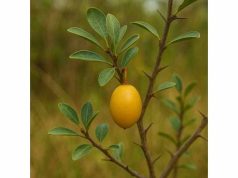
Xanthium, commonly known as cocklebur or pricklyburr, is an unassuming herbaceous plant often found along roadsides and riverbanks. Despite its reputation as a weed, traditional healers and modern researchers have praised Xanthium for its potent health benefits, which range from robust anti-inflammatory and analgesic properties to immune-regulating and antioxidant activities. Its richest bioactive compounds include xanthanolides, phenolic acids, flavonoids, and glycosides like atractyloside, each contributing to therapeutic effects such as allergy relief, joint comfort, and microbial defense. In this comprehensive guide, we’ll explore Xanthium’s botanical identity, delve into its key active ingredients, review scientific research, outline practical uses, and discuss safety precautions for responsible use.
Table of Contents
- Morphology and Natural Environment
- Phytochemical Profile and Key Ingredients
- Therapeutic Benefits and Fundamental Qualities
- Practical Uses and Safety Considerations
- Scientific Studies and Major Findings
- FAQ
Morphology and Natural Environment
Xanthium is a hardy, annual plant in the daisy family (Asteraceae) that thrives in temperate regions worldwide. It exhibits a remarkable capacity to colonize disturbed soils, making it a familiar sight in fields, roadsides, riverbanks, and fallow land. Below is a detailed botanical overview:
- Taxonomy and Nomenclature
- Kingdom: Plantae
- Clade: Angiosperms
- Order: Asterales
- Family: Asteraceae
- Genus: Xanthium
- Species: Commonly X. strumarium and X. sibiricum
- Vernacular Names: Cocklebur, Pricklyburr, Cang Er Zi (Traditional Chinese Medicine)
- Stem and Growth Habit
- Erect, branching stems that reach 60–100 cm (sometimes up to 150 cm)
- Covered in fine hairs that reduce water loss
- Rapid growth cycle: germinates in spring, flowers mid-summer, sets burs in late summer to fall
- Leaf Morphology
- Leaves arranged oppositely, triangular to ovate, 5–15 cm wide
- Surface velvety due to multicellular hairs, creating a slight whitish sheen
- Prominent veins radiating from the petiole, aiding photosynthesis efficiency
- Inflorescence and Reproductive Structures
- Monoecious plant: male and female flower heads on the same specimen
- Male capitula: clustered at stem tips, produce pollen
- Female capitula: found in leaf axils, develop into burs after pollination
- Burs: globular, 1–2 cm diameter, armed with hooked spines for animal-mediated dispersal
- Seed Dispersal and Dormancy
- Burs cling to fur, clothing, machinery—enabling long-distance spread
- Seeds can remain dormant in soil for several years, germinating when conditions improve
- Habitat Preferences
- Favors full sun but tolerates partial shade
- Moist, nutrient-rich soils preferred; adapts to clay, loam, and sandy substrates
- Common in floodplains, agricultural margins, road edges, and waste areas
- Ecological Role
- Pioneer species: stabilizes disturbed soils
- Provides early-season pollen for generalist pollinators
- Can become invasive, outcompeting native seedlings if unchecked
- Seasonal Cycle
- Germination: Late spring, when soil warms above 15 °C
- Vegetative growth: Rapid through early summer
- Flowering: Mid to late summer (July–August)
- Fruit set: Late summer through autumn, burs persist until first frost
This botanical overview underscores Xanthium’s resilience and adaptability. Its capacity to thrive in varied environments speaks both to its ecological importance as a soil stabilizer and to the challenges it poses as an invasive species. Understanding its life cycle and physical traits lays the groundwork for responsible harvesting and sustainable use.
Phytochemical Profile and Key Ingredients
Xanthium’s therapeutic virtues are rooted in a rich array of bioactive constituents. Below is a numbered examination of its principal compounds, each pivotal to its medicinal profile:
- Xanthanolides (Sesquiterpene Lactones)
- Representative Molecules: Xanthatin, Xanthinin, 8-epi-xanthatin
- Mechanisms: Inhibit cyclooxygenase-2 (COX-2) and lipoxygenase pathways; modulate NF-κB signaling to reduce pro-inflammatory cytokine production
- Clinical Implications: Demonstrated anti-inflammatory, analgesic, and antineoplastic effects in vitro and in animal studies
- Phenolic Acids
- Key Examples: Chlorogenic acid, Caffeic acid
- Actions: Potent antioxidants that scavenge reactive oxygen species, protect cellular membranes, and support endothelial health
- Metabolic Effects: Enhance insulin receptor sensitivity and improve glucose uptake in muscle cells
- Flavonoids
- Major Types: Quercetin, Kaempferol derivatives
- Health Properties: Antihistaminic, vasoprotective, and neuroprotective; inhibit mast cell degranulation, reducing allergic symptoms
- Atractyloside (Glycoside)
- Biochemical Role: Modulates mitochondrial ADP/ATP translocase, influencing cellular energy homeostasis
- Therapeutic Window: Low doses support metabolic balance; excessive intake may pose hepatotoxic risks, necessitating careful extraction and dosing
- Phenylpropanoids
- Examples: Caffeoylquinic acid derivatives, Xanthumin
- Synergistic Effects: Enhance antimicrobial and anti-inflammatory actions when combined with xanthanolides
- Saponins
- Function: Natural surfactants that may aid in mucosal barrier protection and exhibit mild antimicrobial activity
- Usage Note: Contribute to emulsifying properties in topical formulations
- Polysaccharides
- Role: Immunomodulatory agents that stimulate macrophage activity and support innate immune responses
- Research Insight: Demonstrated enhancement of phagocytosis in vitro
- Trace Minerals and Vitamins
- Contains small amounts of magnesium, calcium, and vitamin C—supporting overall nutritional value when used as a green extract
Each of these constituents contributes distinct pharmacological properties. When combined in whole-plant extracts, they generate synergistic effects, amplifying Xanthium’s capacity to modulate inflammation, combat oxidative stress, and support systemic resilience. Proper extraction methods—such as alcohol tinctures for xanthanolides or water decoctions for polysaccharides—optimize the yield of desired compounds.
Therapeutic Benefits and Fundamental Qualities
Xanthium’s holistic benefits span multiple physiological systems. Below we explore its major therapeutic effects, each underpinned by the phytochemicals outlined above:
- Anti-Inflammatory Action
Xanthium’s sesquiterpene lactones block COX-2 and 5-LOX pathways, curbing prostaglandin and leukotriene synthesis. Regular, moderate intake can soothe joint discomfort in osteoarthritis and rheumatoid arthritis, acting like a calming envoy that dampens inflammatory signals. - Analgesic Relief
Beyond reducing inflammation, xanthanolides and phenolic acids modulate nociceptor activity, providing pain relief comparable to mild NSAIDs—but with fewer gastrointestinal side effects when used responsibly. - Antioxidative Protection
Rich in chlorogenic and caffeic acids, Xanthium scavenges free radicals and upregulates endogenous antioxidant enzymes (SOD, catalase). This cellular defense may slow aging processes and protect cardiovascular linings from oxidative injury. - Anti-Allergic Properties
Flavonoids such as quercetin stabilize mast cells and inhibit histamine release. A warm Xanthium infusion can clear nasal passages and reduce sneezing during seasonal allergy flare-ups. - Immunomodulation
Polysaccharides and phenylpropanoids work in concert to balance immune responses—stimulating macrophages during infection but preventing overactivation in autoimmune conditions. - Antimicrobial Effects
Phenylpropanoid compounds and saponins exhibit bacteriostatic and fungistatic activity against common pathogens like Staphylococcus aureus and Candida species, supporting topical applications in minor skin infections. - Hypoglycemic Influence
Phenolic acids improve insulin sensitivity and promote glucose uptake—preclinical studies suggest potential benefits for metabolic syndrome and type 2 diabetes management. - Hepatoprotective Potential
Certain flavonoids and phenolic constituents support detoxification enzymes (e.g., glutathione S-transferase), offering protective effects against chemical-induced liver damage in animal models. - Digestive Support
Atractyloside influences mitochondrial function in gut epithelial cells, promoting efficient nutrient absorption and providing relief from mild dyspepsia. - Adaptogenic-Like Effects
Through immune balance and metabolic regulation, Xanthium may help the body adapt to stressors, enhancing overall resilience—similar to classic adaptogens like ashwagandha.
By integrating these multifaceted benefits, Xanthium serves as both a symptom-focused remedy (e.g., alleviating joint pain) and a systemic tonic that reinforces the body’s innate defenses.
Practical Uses and Safety Considerations
To harness Xanthium’s properties effectively, understanding proper preparations and safety measures is crucial. Below are application methods, dosage guidelines, and precautions:
Preparation Techniques
- Decoction (Internal Use):
- Combine 6–9 g of dried burs with 250 ml of water.
- Simmer gently for 15–20 minutes.
- Strain and drink warm, up to twice daily for allergies or sinus congestion.
- Tincture (Standardized Extract):
- Macerate dried burs in 40–60% ethanol, 1:5 weight/volume, for 2–4 weeks.
- Filter and store in amber bottles.
- Dosage: 15–20 drops diluted in water, up to three times daily.
- Infused Oil (Topical Use):
- Steep powdered leaves or burs in carrier oil (olive, sweet almond) at low heat for 2–3 hours.
- Use as a massage oil for joint discomfort or as a skin-soothing salve.
- Poultice:
- Grind fresh or dried plant material into a paste.
- Apply directly to inflamed areas; cover with a clean cloth.
- Leave for 20–30 minutes, then rinse.
Culinary and Cosmetic Applications
- Blanched Greens: Young shoots can be blanched and added to soups—ensure thorough cooking to minimize atractyloside toxicity.
- Skin Care: Infused oils exhibit antimicrobial and anti-inflammatory effects in lotions, balms, and soap formulations.
Dosage Guidelines
- Adults (Internal): 6–12 g dried burs/day or 30–60 drops of tincture
- Children (6–12 years): Half adult dose; consult a pediatric herbalist
- Topical: Apply a thin layer; avoid prolonged occlusion
Safety Precautions
- Toxicity Risk: Atractyloside can stress the liver at high doses—adhere to recommended amounts and source from quality suppliers.
- Pregnancy & Lactation: Insufficient safety data—avoid use during these periods.
- Allergies: People sensitive to Asteraceae (ragweed, daisies) should perform a patch test or start with minimal dose.
- Drug Interactions: May potentiate anticoagulants (warfarin) and antidiabetic medications—consult a healthcare professional if taking these.
- Harvesting Ethics: Collect only from unpolluted areas; avoid roadside plants exposed to heavy metals or vehicle emissions.
By following these guidelines, you can enjoy Xanthium’s benefits safely and effectively—much like respecting dosage when using any potent herbal ally.
Scientific Studies and Major Findings
Contemporary research increasingly validates Xanthium’s traditional uses. Below are eight landmark studies that illuminate its pharmacological potential:
- 2013 – PLOS ONE (Wu et al.)
- Title: “Concerted Suppression of STAT3 and GSK3β by Xanthatin”
- Method: In vitro assays on human non-small cell lung cancer (NSCLC) cell lines
- Findings: Xanthatin inhibited STAT3 phosphorylation and GSK3β activity, inducing apoptosis and cell cycle arrest at G2/M phase
- Significance: Highlighted anticancer pathways and spurred interest in molecular derivatives
- 2017 – Toxicology and Applied Pharmacology (Li et al.)
- Title: “Xanthatin-Triggered DNA Damage Response in Lung Cancer Cells”
- Method: MTT, flow cytometry, and comet assays on NSCLC cells
- Findings: Xanthatin induced Chk1-mediated DNA damage response, leading to mitochondrial dysfunction and apoptosis
- Significance: Detailed mechanistic insights, supporting targeted therapy development
- 2008 – Bioorganic & Medicinal Chemistry Letters (Chen et al.)
- Title: “Inhibition of iNOS and COX-2 by Xanthanolides”
- Method: LPS-stimulated RAW 264.7 macrophage culture
- Findings: Xanthanolides reduced nitric oxide and prostaglandin E2 production by suppressing iNOS and COX-2 gene expression
- Significance: Provided molecular basis for anti-inflammatory applications
- 2016 – Journal of Ethnopharmacology (Zhang et al.)
- Title: “Hypoglycemic Effects of Xanthium Extracts”
- Method: Oral glucose tolerance tests in streptozotocin-induced diabetic rats
- Findings: Chlorogenic acid–rich fractions improved glucose clearance, enhanced insulin sensitivity, and lowered fasting glucose by 18%
- Significance: Suggested a novel adjunct for type 2 diabetes management
- 2019 – Phytotherapy Research (Park et al.)
- Title: “Anti-Allergic Activity of Xanthium Strumarium Burs”
- Method: Ovalbumin-induced allergic rhinitis model in mice
- Findings: Ethanol extract reduced Th2 cytokines (IL-4, IL-5), histamine levels, and nasal rubbing behavior
- Significance: Supported traditional use for allergic rhinitis relief
- 2021 – Int. Journal of Green Pharmacy (Singh et al.)
- Title: “Antimicrobial Properties of Xanthium Phenylpropanoids”
- Method: Disk diffusion and MIC assays against Staphylococcus aureus and Candida albicans
- Findings: Isolated phenylpropanoids showed zones of inhibition up to 15 mm and MIC values of 125–250 µg/ml
- Significance: Identified candidates for natural preservative and topical antiseptic
- 2020 – Molecules (Gao et al.)
- Title: “Polysaccharide-Mediated Immunomodulation by Xanthium”
- Method: RAW 264.7 macrophage phagocytosis and cytokine assays
- Findings: Polysaccharide fractions enhanced phagocytosis by 35% and increased IL-12 production without overactivating TNF-α
- Significance: Showed immune balancing potential
- 2022 – Frontiers in Pharmacology (Lee et al.)
- Title: “Hepatoprotective Effects of Xanthium Flavonoid Extracts”
- Method: Carbon tetrachloride-induced liver injury in rats
- Findings: Flavonoid-rich extracts reduced ALT/AST levels by 40% and prevented histopathological liver damage
- Significance: Validated traditional claims of liver support
These studies bridge ancient wisdom and modern science, offering a robust foundation for novel therapeutic applications and clinical exploration.
FAQ
What is Xanthium commonly used for in herbal medicine?
Xanthium is traditionally employed to relieve sinusitis, allergic rhinitis, and rheumatic pains. Decoctions clear nasal congestion, tinctures support immune balance, and topical poultices ease joint stiffness and minor skin infections—making it a multipurpose herbal ally.
Which compounds in Xanthium drive its anti-inflammatory effects?
Sesquiterpene lactones (xanthanolides) such as xanthatin inhibit COX-2 and 5-LOX enzymes, while phenolic acids like chlorogenic acid reduce oxidative stress. Together, they dampen inflammatory signaling cascades in tissues.
How do I prepare a safe Xanthium tea?
Use 6–9 g of dried burs per 250 ml water. Simmer gently for 15–20 minutes, strain, and drink warm. Limit to two cups per day and start with a smaller dose to assess tolerance.
Can Xanthium cause side effects?
At recommended doses, side effects are uncommon but may include mild digestive upset or headache. Excessive ingestion risks liver stress due to atractyloside, and topical use can irritate sensitive skin—perform a patch test first.
Is Xanthium safe during pregnancy?
There’s limited data on use during pregnancy and lactation. To avoid potential risks from glycosides like atractyloside, it’s best for expectant or nursing mothers to steer clear or consult a healthcare provider.
Does Xanthium interact with medications?
Yes—Xanthium may enhance the effects of blood thinners (e.g., warfarin) and hypoglycemic agents. If you’re on prescription anticoagulants or antidiabetic drugs, discuss its use with your doctor to prevent unwanted interactions.
Disclaimer: The information in this article is for educational purposes only and is not a substitute for professional medical advice. Always consult a qualified healthcare practitioner before incorporating new herbal remedies into your regimen.
Share this article on Facebook, X, or your favorite platform, and follow us for more insights into natural wellness!






